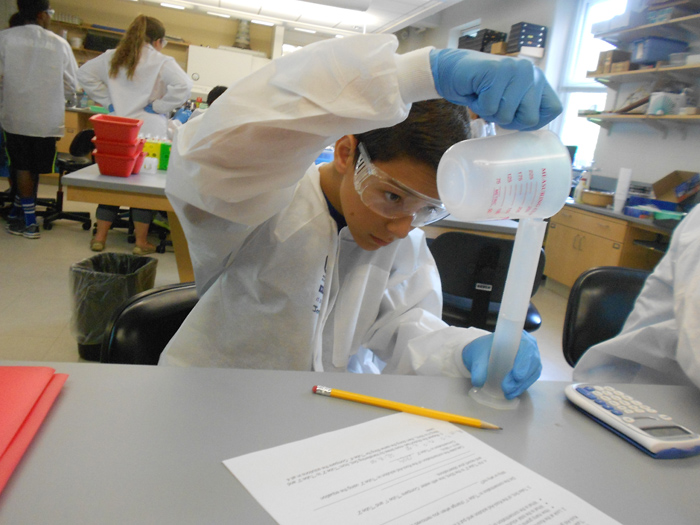A Week in the Life of a GEMS Student

Applications for the 2015 Fort Detrick Gains in the Education of Mathematics and Science program open to students March 11 for the 10th year.
As a summer Science, Technology, Engineering and Mathematics enrichment program, GEMS creates hands-on opportunities for elementary, middle and high school students as well as college students and teachers.
Students in grades four through 12 may apply for any one of the six weeks and seven classes the Fort Detrick program offers.
"The focus of the GEMS program is to touch on all of the STEM categories and to get students excited about STEM and to ignite a passion to find out more," said Lauren Beeson, educational consultant and program coordinator for Fort Detrick's GEMS program.
Last year, the Fort Detrick GEMS program accepted 500 out of 1,000 applicants. This year, the program will accept approximately 525 students.
"Application selection is competitive," said Beeson. "It's not based on previous attendance or how early you apply. We're looking for originality and genuine interest."
So what is a week in the life of a typical GEMS student like? Continue reading for a snapshot of the creative and experimental summers Fort Detrick GEMS students experience.
Class: Intermediate, seventh grade
Day 1
Students arrive in the morning at Hood College, host location for the Fort Detrick GEMS program. They meet all resource teachers and near-peer mentors and receive lab safety instructions along with daily schedules.
After the preliminary morning congregation, students go to their appropriate classrooms with their near-peer mentors and begin with an icebreaker. Then, they jump right into the first activity of collecting insects and learning how to use a dichotomous key to identify and classify them.
In the afternoon, students receive an introduction to Newton's laws of motion, as they circulate through different lab stations including activities such as blowing up balloons while changing the angle of air flow; racing cars on different level ramp heights and comparing the distance the cars travel; and performing the "tablecloth trick," in which they test pulling a tablecloth out from under objects of different weights without disturbing them.
Day 2
Students listen to a career speaker in the morning. The Fort Detrick GEMS program provides a variety of career speakers throughout the program. In the past, representatives from the following various agencies have volunteered their time: the Federal Bureau of Investigation, the U.S. Army Medical Research Institute of Infectious Diseases, the Johns Hopkins University Applied Physics Laboratory, the Armed Forces Institute of Regenerative Medicine, the National Institute of Allergy and Infectious Diseases, the National Cancer Institute, the U.S. Army Center of Environmental Health Research and the Telemedicine and Advanced Technology Research Center.
After returning to their classrooms, students extract DNA from the insects they collected the day before. They learn several lab skills, including gram staining, pipette skills, sterile technique and swabbing for bacteria that is grown overnight.
In the afternoon, students begin building custom rockets, keeping in mind the principles they learned from Newton's laws. By the end of the day, they submit their rocket designs to their near-peer mentors.
Day 3
After listening to a second career speaker in the morning, students return to their classrooms and amplify the extracted DNA of the insects using a Polymerase Chain Reaction.
Students continue building their rockets in the afternoon. They paint, install motors and develop team and rocket names. They learn how to determine the apogee, or highest point, of several objects as practice for their calculations during their upcoming rocket launches.
Day 4
Students go straight to their classrooms on the final day. They run the DNA they amplified the day before out on a gel to determine if any of their insects have the Wolbachia bacteria, a common parasite that infects a high proportion of insects. If students do find a positive sample, they get to send the sample to the Marine Biological Laboratory in Woods Hole, Massachusetts to include in the MBL's national study that tracks how the bacteria infects its hosts and where the infection occurs throughout the U.S.
Students also launch their rockets from the courtyard of Hood College and collect data from the launches.
Finally, students participate in a graduation ceremony at which they receive certificates of completion, a guest speaker, a video presentation and an educational stipend of $100 for the week.
At the end of the graduation ceremony, program leaders invite everyone to visit the classrooms and see some of the projects the students work on throughout the week.
The Fort Detrick GEMS program requires a significant amount of cooperation and coordination from many different groups. The program's success depends on many roles, including subject matter expert volunteers of Soldiers, civilians and contractors to spend time with the students in a variety of ways, from having lunch with them to talk about their passion for STEM and their careers to assisting the near-peer mentors with advanced concepts and training.
"Every year brings something new and exciting," said Beeson. "We always get students who have never done it before and others who return to do a new class. No matter if new or returning, the joy and enthusiasm on their faces are exactly the same. They're just excited to be there."
To apply as a student for the Fort Detrick GEMS program, visit
www.usaeop.com/apply, click the "Fort Detrick, MD (MRMC-HQ)" link and click "Apply." Applications will remain open until April 15.
click the "Fort Detrick, MD (MRMC-HQ)" link and click "Apply." Applications will remain open until April 15.
To apply as a subject matter expert for the Fort Detrick GEMS program, visit
http://stem.amedd.army.mil/index.cfm/opportunities/volunteer to fill out a volunteer form.
to fill out a volunteer form.














